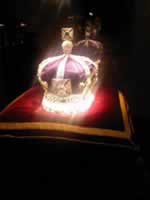Tower of London Page Contents
Tower of London, UK
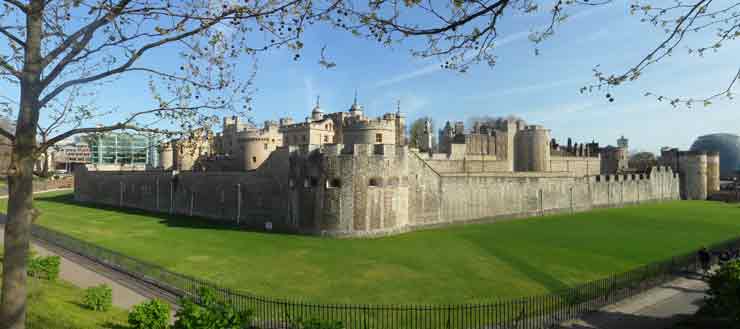
Tower of London North West Corner & the now dry moat.
The Tower of London from Tower Hill, Entrance to the fortress is on the extreme right. The grass area used to be a wide water filled moat at a much lower level, below the river level tin the castles heyday. This made the wall a lot taller before the moat was partially filled in with earth. The photograph gives a good view of the inner wall and some of the inner wall towers showing above the concentric outer wall.
The Tower of London Introduction
- The official name is Her Majesty's Royal Palace and Fortress of the Tower of London
- The Tower of London is one of the United Kingdoms finest Attractions. A quick tour taking in only the main highlights of the Tower can be done in an hour. For a fuller visit where you can join a Yeoman Warder tours that lasts 1 hour allow at least 3 hours overall for a good look around the tower.
- The Tower of London is a Concentric Castle which has 2 sets of walls, one inside the other. Between the 2 walls is the outer ward or bailey inside the inner wall is the inner ward or bailey where you will find the keep the White tower, other buildings of the castle, the execution site & the castle ravens.
- Entrance to the Tower of London is via the Middle Tower, a barbican, which is an outer defence to a gate, always a weak link in a castles defenced, Very prone to a battering ram attack
- This is followed by second drwbrige, now a fixed bridge, then the Byward Tower the Main Gatehouse in the outer wall.
- At the side of the Byward Tower facing the river was a smaller postern gate,now not used, which conected via a drawbridge to a jetty in the river.
- Group parties Entrance is via Tower Wharf ie. The Embankment. Note this entrance may be closed due to a one way system introduced because of Covid and the Main entrance used.
Yeoman Warders known as Beefeaters
- Yeoman-Warders better known as Beefeaters used to be the guards at the Tower & body guards for the Monach. They also ensured that prisoners at the tower did not escape and to guard the Crown Jewels
- They are the oldest continuous military formation in the world, being formed in 1485 by the King Henry V to be his special bodyguard. They were called Beefeaters because traditionally part of their pay was in beef.
- They are Today they act a guides for tower tours and can also be a mine of information.
- Now they must have served at least 22 years in the armed forces, hold theLong Service and Good Conduct medal, and have been a warrant officer or senior non commissioned rank
- Besides there work at the Tower they take part in ceremonies such a searching the cellars of the houses of parliment, of cause dating back to the Gunpowder Plot & Guy Fawkes
- They wear what looks like a tudar style uniform,
- There are 2 uniforms:
- An every day uniform in black with red trim and a large crown & E II R, & trousers
- A Ceremonial uniform in bright red with far more decoration & detail in Gold & black, white neck ruff, knee breeches, hose leggings,
Video of 360 Tour of the Tower of London with Dan Snow
Dan Snow being shown around the Tower of London by Chief Yeoman Warder Alan Kingshott with full informative & historical commentary.
Location of The Tower of London
- On the north bank of the River Thames in central London, of the River Thames in central London inside the London Borough of Tower Hamlets.
- Just outside the "Square Mile of The City of London".
- On the North side is Tower Hill Tube Station & London Wall, a section of the old Roman Londinium, the roman name for London, City wall.
- On the East side is the famous Tower Bridge & The Tower Hotel
- On the South side is the famous is the famous battleship HMS Belfast
Getting to The Tower of London
Transport for London (TFL)
- Tube and Rail Maps, Bus Maps, Cycle Maps & River maps.
- A very Useful Public Transport Journey Planner
- Fares & MORE.
- Website
By Tube (Underground)
- Tower Hill Tube Station
- District and Circle lines
- 4-5 Minute walk
- See location on our map
Bus
- Routes 15, 42, 78, 100, 343 and RV1 stop nearby the Tower of London in.
By Open Top Sightseeing Tour Buses
- All the major sightseeing bus tours in London pass-by the Tower of London.
- Some of these have more than 1 route, such as Red Route, Blue Route, ect. Ensure you board for the correct route.
- Bus Tour only or Tour + Tower of London depending on the bus line selected
By River
- River Service Boats
- Cruise Boats. Cruise only or Cruise + Tower of London depending on the cruise line selected
By Taxi or Mini Cab
- Taxis known as Black Cabs can be hailed on the street by raising your hand & arm if the roof top taxi sign is lit. Note it is actually illegal to shout out Taxi. They can be also booked by phone or app.
- Tuesday - Saturday 09:00 - 17:30
- Mini Cabs can NOT be hailed. They must be booked by phone or App
By Car
- Nearby car parks
- Tower Hill Coach and Car Park with Accessible parking (2 minute walk)
- 50 Lower Thames Street, London, EC3R 6DT
- Minories car park (10 minute walk) – 1 Shorter Street, London, E1 8LP
- Mini Cabs can NOT be hailed. They must be booked by phone or App
Opening Times
Summer
- Sunday & Monday 10:00 - 17:30
- Tuesday - Saturday 09:00 - 17:30
- Last admission 17:00
Winter
- Sunday & Monday 10:00 - 16:30
- Tuesday - Saturday 09:00 - 16:30
- Last admission 16:00
Book The Tower of London
Tower of London Online Tickets
- Avoid the Ticket Queue by purchasing a ticket on line Tower of London Tickets
- Enjoy 1 day admission to the Tower of London.
- Explore all of the exhibitions and get up close with the Crown Jewels.
- Beefeater Tours included
Tower of London Ticket Office
- The ticket office is near to the site entrance from the main A100 road, Tower Hill.
Tower of London Moat
- The moat is 100 ft. wide and now the bottom is lawn grass covered, and often contains exhibits. Originally the moat was much deeper & connected to the Thames river filling it with water.
Inner Wall
- When built The current Inner Curtain Wall was the only wall surrounding the White Tower and incorporated some of the old roman fortress walls.
- The southern side was built against the river, & a moat on the other 3 sides where the current outer ward (bailey) is now.
Outer Wall
- The Outer Wall was built later in the river. The space between the the 2 wall was filled in with earth to from the new moat dug outside the outer wall..
- This made the old moat above the water line and the outer bailey.
- The fortress was now a concentric castle with 2 concentric walls surrounding the the keep, The White Tower,.
- The section parallel to the river is now called Water Lane & the western section called Mint Lane.
- The Outer bailey was also split into sections by cross walls, now destroyed
- The original Inner bailey was also divided by a wall visible on the right after entering through the Bloody Tower, & a gate, creating a middle bailey, where the scaffold & Wellington Barracks are, and an inner bailey, where the entrance to the white Tower & the ravens are.
Main Entrance to Tower of London The Middle Tower
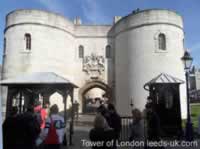
Middle Tower, Tower of London Main Entrance.
- Ticket & Bag check before the Middle Tower drawbridge
- Tickets can be purchased 150 metres up Tower Hill on the left near the A3211 main road, Tower Hill Terrace
- Buy Tickets online
- The main entrance is through the Middle Tower, where the ticket checking box is, locate on the West side of the Castle, the same side as the ticket office, next to the River.
- Beyond the Middle Tower, is the bridge the start of the guided tours, then the Byward Tower in the Outer Wall.
- Before the ticket collection box look down over the railings on the left to see in the excavationsthe foundations of the and Drawbridge pit of the curtain wall of the Lion Tower
- The Lion tower, almost a mini castle, was built as additional defences before the Middle Tower gate.
- See the Location of the Main Entrance to the Tower of London on our Tower of London Map
Secrets of the Tower of London Video
Group Entrance to Tower of London - Henry III’s Watergate
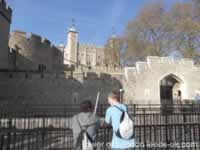
Group Entrance The Tower of London. Located on the River Thames Embankment
Due to Covid restrictions and a one way system in parts of the fortress this is now an EXIT ONLY
As far as we know Groups NOW enter by the Main Entrance
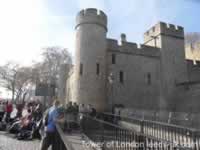
A group waiting next to St. Thomas’s Tower & near the Group Entrance
- Due to covid restrictions & a one way system around parts of the tower, this is now an exit only.
- The Group Entrance is 500 metres from the Main Entrance round the corner & along the wide Riverside Walk just past St. Thomas’s Tower - Traitors gate.
- St. Thomas’s Tower is easy to spot it juts out about 10 metres from the outer wall.
- On the right hand side of the towere you will see the zig zag iron railing in front of the entrance, which is just a gateway in the wall & not a tower .
- See the Location of the Group Entrance to the Tower of London on our Tower of London Map
The White Tower
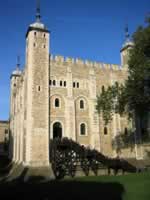
White Tower Entrance on the first floor
Photo by James Byrum
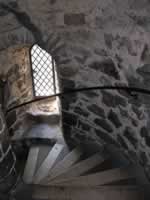
Tower of London Spiral Staircase
Photo by AESanfacon
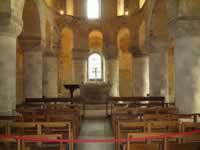
Tower of London St Johns Chapel
- The White Tower gets it's name because the walls of the tower were painted with whitewash a low cost paint made from slaked lime (calcium carbonate) & chalk.
- Possibly the most famous castle keep in the world and easily recognised from it's 4 iconic roofed turrets, 3 square ones and 1 round one, at the corners raising above the battlements.
- The Tower was built to subdue the idea of revolt by the recently conquered Londoners & English by the Normans
- The Tower was built to a fearsome size:
- 118 x 177 feet (35.9 x 32.6 metres) & 90 feet (27.4m) high on the downhill side.
The wall thickness is 15 feet (4.6 metres) at the base thinning to 11 feet (3.4 metres) near the top.
- 118 x 177 feet (35.9 x 32.6 metres) & 90 feet (27.4m) high on the downhill side.
- As a defensive features:
- The entrance was on the first floor
- The floors were divided into 2 with a wall down the centre. This also made floor boarding easier.
- There was only a single easily defended spiral staircase, in the round tower, from the entrance hall, also the guard room to the rest of the castle
- The direction of spiral would give defenders on the higher level an advantage. It is difficult to weald a sword using the right hand if attacking up the stairs. The central column is in the way
White Tower tours
- White Tower tours are conducted by the Yeoman Wardens
- Daily at 10.45, 12.45, and 14.15.
Recommended Visiting Time for the White Tower
- 40 minutes & includes time for Fit for a King.
- See the Location of the White Tower on our Tower of London Map
Crown Jewels & The Waterloo Barracks
Imperial State Crown. Photo by johnjones
- The Crown Jewels are displayed in the Jewel House within the Waterloo Barracks Block.
- The Crown Jewel collection contains 23,578 gems that include the Worlds most famous diamonds the massive Cullinan I and the notorious Koh-i-Noor.
- The Imperial Crown, see photographabove, alone contains 2,868 diamonds, 273 pearls, 17 sapphires, 11 emeralds and 5 rubies.
- The value of the Crown Jewels is
- Crown Jewels are protected by being located in a vault & surrounded by armoured glass.
- Viewing is from a moving pavement to keep the crowds moving past. If there is no queques you can go around again.
- Visit early mornings & not in school holiday periods to avoid the queues.
- Waterloo Barracks also known as Waterloo Block was built in 1845 as Barracks for 826 single, ie. not married, soldiers.
- From 1967 it has housed the fabulous Crown Jewels.
- The rest of the building is now office administation.
Recommended Visiting Time to view the Crown Jewels
- 35 minutes but allow for very long queues at peek times
- See the Location of the Crown Jewels on our Tower of London Map
Torture at the Tower in the Wakefield Tower
- See the exibition in the Wakefield Towerr with replicas of the terrying pain inflicting instruments of torture such as:
- The Rack to stretch the victim
- The iron manacles fastened around the wrists then raised off the ground byropes conected to the manicales.
- The Scavengers Daughter was the opposite treatment to the Rack where the victim was fasted into an iron frame the could be made smaller contorting the body & compressing it
Beauchamp Tower
- The Beauchamp Tower was built by Henry the III and Edward I as part of the Inner Wall around 1281
- This tower is roughly in the location of the original entrance to the Tower when only the 1 wall & White Tower existed.
- The tower was used at various times as a prison for important prisoners such as:
- Sir Philip Howard, Earl of Arundel. Died as a prisoner 10 years after imprisonment during the reign of Elisabeth I.
- Lord Cobham spent the last 14 years in James I's reign
- Robert Dudley the childhood sweetheart of Elizabeth I. He was held for one year.
- The wall are covered in prisoners graffiti mainly carved during the 16th & 17thcenturies, a period of both political & religious unrest.
- See the Location of the Beauchamp Tower on our Tower of London Map
Bell Tower
- The Bell Towerhas located on the corner of the inner curtain wall nearest the Main Entrance
- The Bell Tower was the first tower to be built after the White Tower and its purpose was to stengthen the curtain wall surround the keep.
- A small wooden turret on top of the tower housed the curfew & alarm bell. Now the bell sounds at 5:45 pm warning visitors of the pending closing of the Tower.
- When built the Bell tower rose from the rivers Thames edge.
- The outer curtain wall was built at a later date pushing back the river.
- Note how the tower changes shape from an octagonal to a circular shape from the base of the second floor. Octagonal & Round towers were much stronger than Square ones where attacks would mine under a corner collapsing the tower.
Broad Arrow Tower
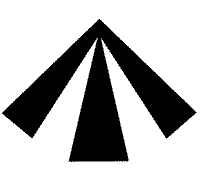
Goverment Broad Arrow.
- The Broad Arrow Tower was used.by the goverment department in charge of the Wardrobe where royal robes and valuable furnishings were kept here.
- The name of the tower is taken from the Broad Arrow that is used to mark Crown property. Today you will see the symbol on modern Military equipment, goverment stationary & other crown property.
- This tower is now presented to the public as a Guard Tower and is on the East Wall Walk
Byward Tower & Postern Gate. The Main Entrance
- The Byward Tower and Gateway is the Main entrance through the Concentric Outer Curtain Wall., and built by Henry III, and strengthened by Richard II in the mid 13th-century
Byward Tower Defences
- Part of the bridge in front of the tower was originally a drawbridge
- The tower had 2 portcullises & murder holes in the ceiling
- Set within the moat were further gate houses each with there own portcullis
- Middle Tower. Called the Middle Tower because it was located between the Lion-Tower & the Byward Tower
Lion-Tower

The Lion Tower demolished in the 1800s. Only the drawbridge pit is still visible. The Middle Tower is on the left, now the Main Entrance
- Before being demolished in the 1800s the Llion Tower & D shaped bailey & curtain wall, were located within the moat, there fore fully surrounded by water.
- Only the below ground level runs of the Lion Tower's drawbridge pit are now visible.
- Look for the foundations to the left & down as you walk toward the tower entrance from Tower Hill. You will see some wire frame animals & the pit
- 1 or 2 additional towers before the Lion Tower are thought to have existed but no trace has been found. See old painting where one of these additional small tower gates is shown on the land side of the draw bridge.
- Lions were housed in the D shape bailey with it's curtain wall conected to the Lion Tower. The drawbride ran fom this cutain wall
The Tower of London C. 1300

Tower of London c1300 by Ivan Lapper
- Many changes have been made to the tower since 1300. See how many you can spot.
Byward Tower Wall Paintings discovery
- During recent restorations fabulous wall paintings have been discovered within the Byward Tower The paintings are in a critical state & there stability is being checked. Depending on the results, the public may be allowed to see them.
St Thomas's Tower & Traitors Gate
Traitors Gate
- The most famous Gate in the Tower of London.
- Located as part of St Thomas's Tower taking up most of the Ground Floor and basement.
- Originally river before the building of Tower Wharf Embankment
- Built by Edward I between 1275 and 1279 as the main water entrance from the Thames. The building of the Tower Wharf Embankment cut it off from the river
St Thomas's Tower
Yeoman Warder Guided tours
- The Free Guided tours start just inside the Main Entrance every 30 minutes, starting at 10am & the last one is at 3:30pm
- They last 45 minutes and are in English Only.
- Audio guides are available in different languages from the shop inside the entrance on the right
- Also just inside the gateway on the right is an information board & a shop where audio guides can be purchased
Postern Gate of the Middle Tower
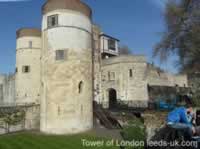
Byward Tower & Postern Gate in the photo centre.
- Built on the river side of the Byward Tower is a smaller tower which houses the Postern Gate. This tower can only be seen from outside the walls. This Postern Gate was protected with a drawbridge
- The Byward Tower & its Postern gate extension are closed to the public, other than passing through the Byward Tower tower on your entrance into the fortress.
Bloody Tower & Gateway
- Previously called the Garden Tower
- Renamed after the disappearance of the two princes 12-year-old Edward V and his younger brother, Richard, in 1483 from their first floor accommodation (prison)..
- It was widely believed they were killed on orders of their uncle who then became king Richard III.
- In the reign of James I Sir Walter Raleigh's was held as a prisoner for 13 years, on the ground floor in a degree of comfort such as having 3 servants. The king then had Raleigh executed for treason. It was probably a political execution to appease the Spanish
Nearby Attractions
Tower Bridge
- Londons most famous Bridge
- Located next to the Tower of London
- More Information Tower Bridge
HMS Belfast
- A Royal Navy World War II light cruiser warship
- Located: On the South bank of the River Thames opposite the Tower of London
- .More Information HMS Belfast
St Katharine's Dock
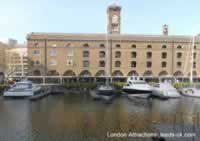
St Katherine Docks and Marina.
- Originally a large dockland ship basin surrounded by warehouses.
- Now converted to a Tourist Attraction.
- Boat & yacht marina
- Bars, pubs & restaurants
- Pleasing & photogenic area
- .More Information
Hay's Galleria
- A very interesting shopping centre with bars, restaurants, shops, market stall
- Located on the South Bank of the River Thames by HMS Belfast's bow
- Cross the river by river boat
- .More Information Hay's Galleria
All Hallows Church by the Tower
- All Hallows by the Tower is the oldest church in the City of London
Gardens & Memorial to Seafarers Monument
- Located just over the Tower Hill main road. Use the pedestrian subway



